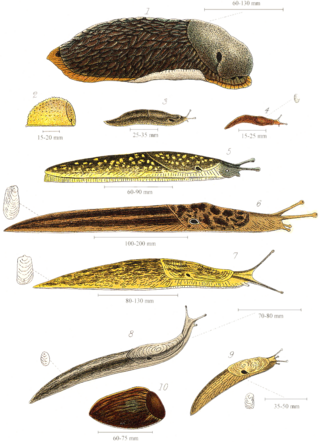Related Research Articles

Limacus flavus, known commonly as the cellar slug, the yellow slug, or the tawny garden slug, is a medium to large species of air-breathing land slug, a terrestrial pulmonate gastropod mollusk in the family Limacidae.

Onchidiidae are a family of small, air-breathing sea slugs. They are shell-less marine pulmonate gastropod molluscs. Onchidiidae is the only family within the superfamily Onchidioidea.

Arion distinctus is a species of air-breathing land slug in the family Arionidae, sometimes known as the roundback slugs. It is a terrestrial pulmonate gastropod mollusc. Several vernacular names exist, but it is unclear if they are much in use: brown soil slug, common garden slug, darkface arion, Mabille's orange-soled slug, April slug.
The snake skin hunter slug is a species of land slug in the family Chlamydephoridae. It is endemic to South Africa, where it is known from six localities in KwaZulu-Natal.
Purcell's hunter slug, scientific name Chlamydephorus purcelli, is an endangered species of air-breathing land slug, a terrestrial pulmonate gastropod mollusk in the family Chlamydephoridae.
Gulella salpinx, common name Trumpet-mouthed hunter snail, is a species of very small air-breathing land snail, a terrestrial pulmonate gastropod mollusk in the family Streptaxidae.

The Tongaland cannibal snail, scientific name Natalina wesseliana, is a species of medium-sized predatory air-breathing land snail, carnivorous terrestrial pulmonate gastropod mollusc in the family Rhytididae.

A land snail is any of the numerous species of snail that live on land, as opposed to the sea snails and freshwater snails. Land snail is the common name for terrestrial gastropod mollusks that have shells. However, it is not always easy to say which species are terrestrial, because some are more or less amphibious between land and fresh water, and others are relatively amphibious between land and salt water.

Streptaxidae is a family of carnivorous air-breathing land snails, terrestrial pulmonate gastropod mollusks in the clade Stylommatophora. Six Streptaxidae subfamilies are accepted in the 2005 taxonomy of the Gastropoda by Bouchet & Rocroi.

Slug, or land slug, is a common name for any apparently shell-less terrestrial gastropod mollusc. The word slug is also often used as part of the common name of any gastropod mollusc that has no shell, a very reduced shell, or only a small internal shell, particularly sea slugs and semi-slugs.

Ellobiidae, common name the hollow-shelled snails, is a family of small air-breathing land snails, terrestrial pulmonate gastropod mollusks in the clade Eupulmonata. Ellobiidae is the only family in the superfamily Ellobioidea, according to the taxonomy of the Gastropoda by Bouchet & Rocroi, 2005).

Oopeltidae is a family of air-breathing land slugs, terrestrial pulmonate gastropod mollusks in the superfamily Arionoidea.

Ariophantidae is a taxonomic family of air-breathing land snails and semi-slugs, terrestrial pulmonate gastropod mollusks in the superfamily Helicarionoidea.

Urocyclidae is a family of air-breathing land snails, semi-slugs and land slugs, terrestrial pulmonate gastropod mollusks in the superfamily Helicarionoidea,.

Vallonia pulchella, common name the lovely vallonia, is a species of very small air-breathing land snail, a terrestrial pulmonate gastropod mollusk in the family Valloniidae.

Prestonella is a genus of air-breathing land snails, terrestrial pulmonate gastropod molluscs in the family Bothriembryontidae.

Prestonella nuptialis is a species of air-breathing land snail, a terrestrial pulmonate gastropod mollusc in the family Bothriembryontidae.

Prestonella bowkeri is a species of air-breathing land snail, terrestrial pulmonate gastropod molluscs in the family Bothriembryontidae.

Deroceras invadens is a species of air-breathing land slug, a terrestrial pulmonate gastropod mollusc in the family Agriolimacidae. Until 2011, this widely distributed species was known as Deroceras panormitanum, and earlier as Deroceras caruanae or Agriolimax caruanae, but Reise et al. (2011) showed that these names refer to a distinct species of similar external appearance known at that time only from Sicily and Malta. Consequently, although the more widespread species was already well known, it then had to be redescribed under the new name of D. invadens. Genetic evidence has indicated that D. invadens is native in southern Italy, including parts of Sicily, and possibly parts of central Italy. Elsewhere it has been introduced, predominantly within the last 100 years, but its spread has been constrained by cold winter temperatures.
References
- 1 2 Herbert D. G. (1997). "The terrestrial slugs of KwaZulu-Natal: diversity, biogeography and conservation (Mollusca: Pulmonata)". Annals of the Natal Museum 38: 197-239. PDF.
- ↑ Heynemann (1885). Jahrb. dtsch. malak. Ges.12: 20.
- 1 2 3 G. M. Barker, ed. (2004). Natural Enemies of Terrestrial Molluscs. p. 317.
- ↑ Herbert D. G. (2000). "Dining on diplopods: remarkable feeding behaviour in chlamydephorid slugs (Mollusca: Gastropoda)". Journal of Zoology 251(1): 1–5. doi : 10.1111/j.1469-7998.2000.tb00586.x.